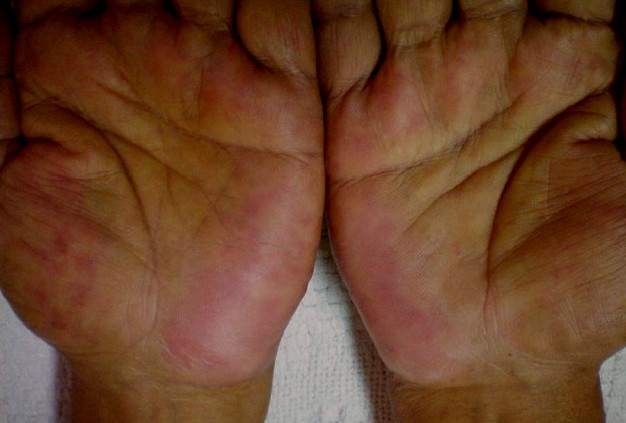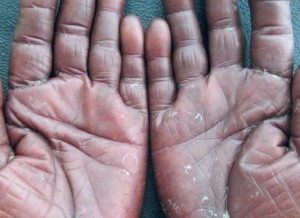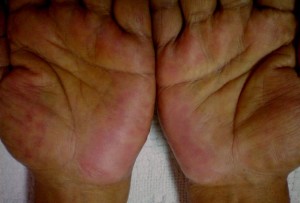Palmar erythema is a condition that affects the palm of hand and presents in form of reddening, especially at base of the thumb and little finger. This is a skin condition, which tends to be localized— because it shows up only in the hand and the palms. The incident of this condition may be associated with some underlying conditions and therefore, a medical evaluation is needed to determine what could be causing this kind of skin conditions. Palmar erythema mostly affects parts of the hand including the hypothenar eminence, thenar eminence, and the fingers.
It may be found on soles and feet at times, but this is termed as plantar erythema. This condition is common among people who have rheumatoid arthritis. Palmar erythema is also associated with liver cirrhosis and women who take oral contraceptives.
Skin is considered the largest organ in the body and when there are significant changes, they may arise due to some underlying causes. Although having palmar erythema is generally not a very serious thing, when the palm of the hand changes and becomes red, and it is accompanied by molting, then this is seen as an alarming issue.
Many conditions are linked to palmar erythema including high blood pressure. This skin condition of the palm is quite difficult to distinguish because it tends to be similar to other skin disorders, which have similar clinical presentations. A number of skin disorders can affect the palm of hand. Therefore, identifying palmar erythema will need proper examination on how it presents.
The identification of palmar erythema helps determine the root cause of the condition, so that medication is aimed and targeted on that underlying cause. At times, when it is thought that the skin condition is arising from some more threatening conditions, tests are conducted. An inflammation may occur, however, the onset of the palmar erythema does not always present in form of an inflammation.
At times, the inflammation may be seen elsewhere away from the palm of hand but it presents itself with the development of palmar erythema. Therefore, this is a condition that can have a complicated process of diagnosis.
Palmar Erythema – Causes
Palmar erythema is localized and only affects the hands, and in addition, its onset may be a sign of an underlying condition. Therefore, the palmar erythema may be a condition by itself or it may be a sign of some other disease or disorder. The occurrence of palmar erythema is due to perfusion of palm.
The most implicated cause of this skin disorder is the increased levels of estrogen since increase in this hormone is thought to affect the way in which the endometrial capillary density occurs — this in turn creates a similar effect on the hand’s palm.
There are two forms of this skin condition of the palm, and they include primary palmar erythema and secondary palmar erythema. The former is a situation where the palmar erythema is a condition or disorder by itself and not linked or associated with an underlying disease or conditions. Usually, the cause is quite unclear and not linked to an existing medical issue. Pregnancy is seen to be the most common triggering factor for the primary palmar erythema.
The latter meaning secondary palmar erythema exists due to an underlying condition or a situation where there is a condition influencing the primary palmar erythema. The causes have been associated with chronic liver disease, rheumatoid arthritis, hyperthyroidism, and neoplasm.
Symptoms of palmar erythema
There are a number of pathophysiological processes that occur in people with this skin disease and the balance of these processes may vary depending on the causes. These processes include localized inflammation, high circulating oestrogen levels, capillary dilation in palms, and increased cardiac output or hyperdynamic circulation.
The symptoms of palmar erythema include a warm reddening of the palm especially at base of the thumb and the little figure. However, it may also appear elsewhere in the parts of the palm. It may present in form of a general discoloration of palm. It exists without other symptoms associated with skin conditions like itching, pain, and scaling, but an inflammation may occur. The inflammation could be coming from other parts of body meaning that this inflammation is only known through the palmar erythema.
Palmar erythema may manifest with molting and it may also blanch especially when pressed or it is put on a pressure. When the skin in palmar erythema is blanched, it momentarily returns to the reddening hues when the pressure is released. The reddening seen in the palm may vary from one person to another. When there is an underlying condition being associated with palmar erythema, symptoms may vary depending on the particular condition.
Treatment
There may be no specific treatment for palmar erythema and much of treatment depends on the identified cause of primary palmar erythema and the secondary cause. This is a non-specific condition. It can occur in persons due to an underlying disease.
It may also occur in people who are healthy and don’t have a previous medical history. In healthy individuals, the skin condition may resolve on its own, but it is important to see a doctor. In those who have medical issues connected to palmar erythema whether primary or secondary, they need to get the right treatment.
Palmar Erythema – Pictures



